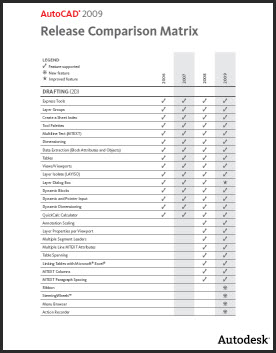Create 3D Models directly from images…
I have not tried this out yet – but it sure sounds interesting.
Here is what the Autodesk site says…
Autodesk ImageModeler image-based modeling software enables architects, designers, and entertainment content creators to quickly and easily create 3D models from 2D digital images or panoramas.Use ImageModeler to capture the reality as-built:* Reconstruct photorealistic objects, scenes, and cities
* Integrate CAD projects with existing environments
* Take measurements of buildings
The software’s easy-to-learn, three-step workflow—calibration, modeling, and texturing—lets you achieve, stunning, photorealistic modeling with real-world accuracy. Additionally, ImageModeler 2009 offers support for Autodesk® 3ds Max®, Autodesk® Maya®, and AutoCAD® software.
Calibration
Calibrate the software for one to many pictures by matching a few points between the images. There is no need to input information about the camera.
Modeling
The modeling tools in ImageModeler are simple. A 3D model is generated using polygonal primitives. This model can then be refined by the user and detail added.
Texturing
Photorealistic texture maps are automatically extracted from the pixel information of the source images.
Or Download a Trial and try it out
.
From the Autodesk website…
What feature was introduced when?
This matrix shows the availability of many features from version 2006 through 2009.
Journal of Building Information Modeling
The Fall 2008 issue is out. You can view a PDF here.
The National BIM Standard of The National Institute of Building Sciences (NIBS) is pleased to announce the Fall 2008 issue of the Journal of Building Information Modeling, an essential information source on business, standards and technical issues related to BIM.
See prior issues here.
Another issue that will render your standard pretty much useless when you may think it is not.
A Useless CAD Standard is…
Not Read
Your users are not reading your CAD Standard. They may have never read it, or they may not have read it recently. You take the time to write it, print it, publish it, and distribute it— but no one reads it. It is useless because people do not know what is in there.
Avoiding this trouble:
Make sure that everyone has a copy. You may have done so when it was first published,but what about new hires. Do they have a copy?
Hold training classes on it. Actually provide training in your standard. Tell people what is in there. Go over it one page at a time. Tell them what and why you selected each standard.
Now we turn to another issue that will render your standard pretty much useless at some point.
A Useless CAD Standard is…
Not Updated
Waiting too long to update your standard can make it functionally useless. It will actually work, but is outdated and not covering what is needed for the newest release of your software. There may be items not covered or covered in an outdated manner. there may be areas that are totally not included since they did not exist when the last update was done.
Avoiding this trouble:
Update it – simple enough. Make a plan and start working through the issues that are missing or outdated. Take them one at a time and in the priority that impacts the projects the most. Move from issues not covered at all (do these first) to those not covered well enough. Fix typos and wording as you move along. Expand on the areas that have changed. Remove areas that are no longer needed.
Last time we talked about an incomplete standard being useless. Now we move on to another issue that may make your CAD Standard Useless.
A Useless CAD Standard is…
Not Enforced
When you fail to enforce your standard, it soon becomes useless. If there are no consequences for not following the standard, then why should people follow it. People will try to duck the standard, avoid the standard and set it aside. Managers will try to get their team to not use it if they feel it is slowing their project down. Users will ignore it if they think it is irrelevant.
Avoiding this trouble:
Set up a process for reviewing the projects for standards compliance. Have them reviewed and fixed. Get your upper management to understand the need for compliance. Don’t let projects slide when they are not following the standard. Take it as far to the top as you need to. Don’t let up.
CAD Standards can be a very useful tool for getting all your team on the same page. Making sure that all users know what to do and how to do it can streamline operations and make things run smoothly.
There are a few things that may make your extensive efforts are defining, refining and writing down you CAD Standard less effective and even useless.
A Useless CAD Standard is…
Not Complete
Holes in the standard force users to “figure it out alone”. When that happens they chew up time and come up with some interesting solutions. Differing approaches by users because the standard does not tell people what to do can make the document useless. Soon users will lose faith that the book has any answers. They will stop turning to it and just make up guidelines on their own.
The incomplete “blanks” will be “filled in” by your studios, groups and offices in various ways. They may start sharing methods amongst themselves and not telling you. They may start calling their friends at other firms. They may start grabbing ideas off the internet. There is nothing inherently wrong with any of these, but they defeat your unified process. Each one takes a different perspective and none of them match.
This “difference of opinion” that creeps into your environment can be a killer. When divergent methods appear in drawing creation, it makes it harder to share files between users.
Avoiding this trouble:
Find out what users are doing. Ask around to see how what they think is missing from the standard. They may not think that anything is missing, so ask them what they have been figuring out on their own. These are the areas that need expanding. They may ask questions about missing topics. These are the areas you need to define.
You can also review your standard for holes. Think of the entire process of putting together a set of files and what each step would take. If it matters what the users are doing in each step and they are not doing the same things, then start talking each one of these areas out. Get consensus on the topic and write it into the standard.
Intuition
Intuition is the capacity of knowing something without necessarily using a rational processes. It is a gut feeling and a sense that something lies beneath the surface or behind the screen. Knowing what that unspoken “thing” means can be a great advantage to your firm.
It allows you to move past the surface and get to the crux of the situation. No one will escort you there. You have to get there yourself. Some say that you are born with it. Some say it can be learned. I think it is a little of both.
I think the more information you have the better your intuition will become. The more you think about things the better you will be at thinking beyond the obvious. The more you talk to others and get a broader view, the better you will be at knowing what might come next.
Intuition will move you forward if you use it to your advantage and don’t overplay your cards. Intuition gone wild becomes “jumping to conclusions”. By going too far out on a limb or getting to your “gut feeling” too soon, you risk misinterpreting the situation. Then you will actually start harming others.
Intuition should not be overused. You may know what might happen next, but you may not want to share that with others. Try your hunches without telling others what you are doing. That way you can hone your skills before you have troubles by guessing wrong.
Let’s get moving!!!
Come on – we can do this
Don’t stop now – we are really close
It will get better.
All of these comments above come from the enthusiasm that can be generated by the CAD Manager.
Just being energized and excited about the future can make things happen. Do you generate excitement about the future? Or do you kind of think it might not be so good?
Enthusiasm is contagious. People should be catching it from you. You need to be a positive enfluence within your firm. This can be hard if you are also the “CAD Cop”. Balancing a positive attitude with the enforcement of a Standard can be tough. But it is doable.
Bringing positive energy to your firm will encourage others to also have a positive outlook. Positives make more progress than negatives.




